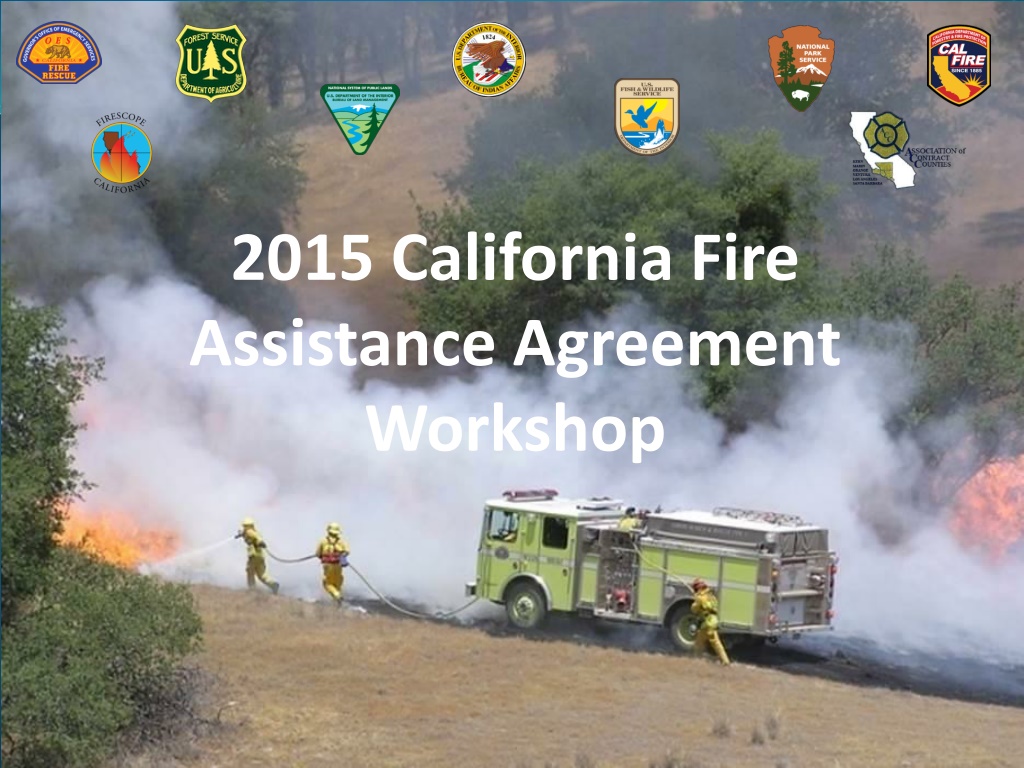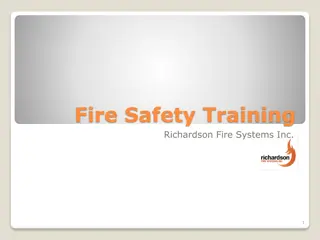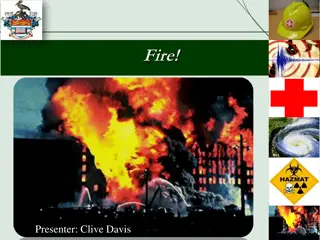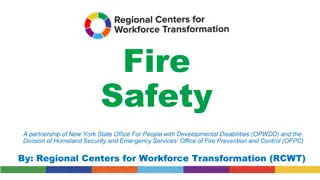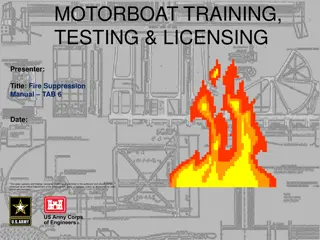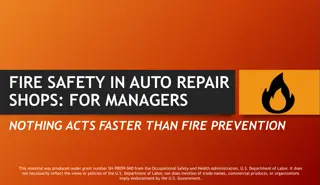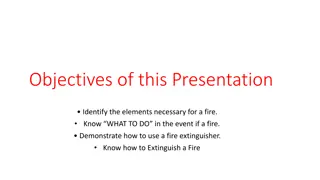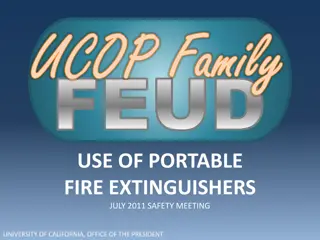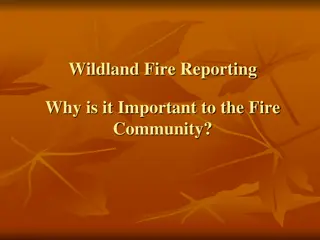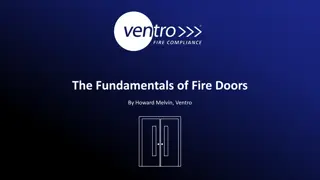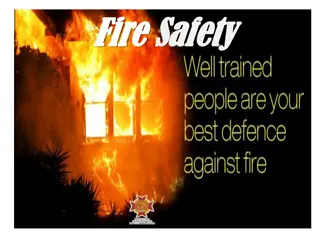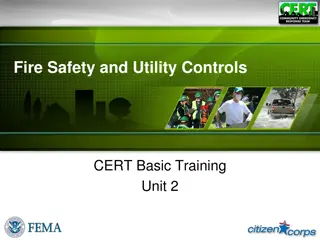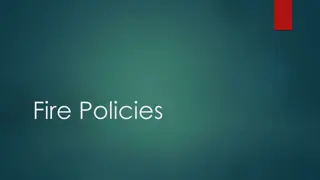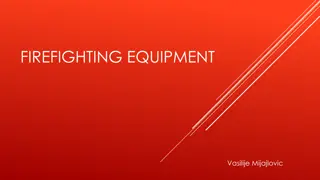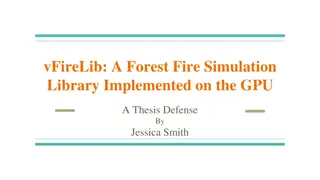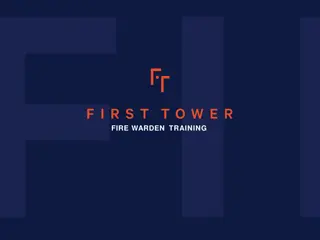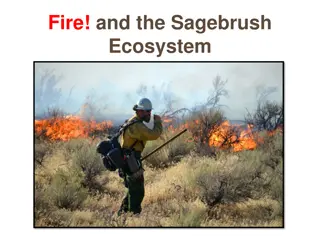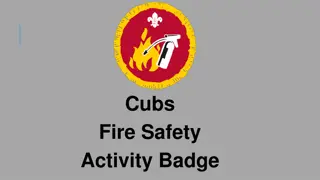California Fire Assistance Agreement Workshop 2015 Overview
This workshop focuses on the California Fire Assistance Agreement (CFAA) for mutual aid, outlining expectations, rates, and processes to support local government fire agencies. It covers the purpose, agenda, administrative rate calculations, and the intent to compensate agencies for assisting the state and federal entities.
Download Presentation

Please find below an Image/Link to download the presentation.
The content on the website is provided AS IS for your information and personal use only. It may not be sold, licensed, or shared on other websites without obtaining consent from the author. Download presentation by click this link. If you encounter any issues during the download, it is possible that the publisher has removed the file from their server.
E N D
Presentation Transcript
2015 California Fire Assistance Agreement Workshop
Introduction Welcome Introduction of Cadre Members What is the CFAA and why do we need it? How did we get here? CFAA Committee Negotiation Process
Purpose Provide an understanding of expectations on the different Memorandum Of Understanding (MOU s), Memorandum of Agreement (MOA s), Governing Body Resolution (GBR s) or equivalent language, etc. Assist local government fire agencies in developing accurate rates per the type of classification held. Support successful implementation of existing language and changes for 2015.
Agenda CFAA Intent No 12-Hour Free Period for DOI Agencies Actual Administrative Rate Due Date MOU/MOA/GBR or equivalent Due Dates Above straight time above a BC Review Process Supplemental Personnel exclusion
Agenda (cont.) Suppression, Non-Suppression and Supplemental Personnel definitions 2015 Rate Letter Base Rates/Formula New OES F-42 DOD and Tribal Fire Departments Reimbursement of fractional hours
Agenda (cont.) SAM Registration Rental Vehicle Use Exhibit G: Out-of-State assignments - travel, per diem and misc. approved reimbursement process Exhibit H: In-State assignments travel, per diem and misc. approved reimbursement process 6
Agenda (cont.) Actual Administrative Rate Calculation Average Actual Rate Calculation Suppression & Non Suppression Establishing Supplemental Personnel Rates 7
The CFAA Intent : It is the intent of the signatories to the CFAA to compensate California Fire and Rescue Mutual Aid System Agencies for the cost of assisting the State of California and the Federal Fire Agencies. The rates, methodologies, and formulas in the agreement are intended to provide for such costs. The compensation shall be consistent with the California Fire and Rescue Mutual Aid System Agency s normal internal business practices and any existing memorandum of understanding (MOU)/memorandum of agreement (MOA) or governing body resolution, or equivalent which supports those business practices. (pg. A-1) 8
Overview and Changes 12 Hour Free Period Exception: Department of Interior Agencies will reimburse from initial time of dispatch. There will be NO 12 hour free period for order and requests from BLM, NPS, FWS and BIA. USFS and CAL FIRE will still require a 12 hour free period. 9
Overview and Changes Actual Administrative Rate Due Date: Local government fire agencies who prefer to develop an actual administrative rate, are required to develop and submit a new rate by July 1, of each year. Failure to submit each year before this date, will default your agency to the base administrative rate set annually each year by the committee (The rate is 10%). 10
Overview and Changes Definitions for personnel hours PORTAL TO PORTAL shall mean the time of initial dispatch from home base to the time of return to home base. ACTUAL HOURS WORKED shall mean the time/hours actually worked on the incident. 11
Overview and Changes Memorandum of Understanding (MOU), Memorandum of Agreement (MOA), Governing Body Resolution (GBR) or Equivalent: Any agency seeking reimbursement for personnel for more than actual hours worked on an incident (PORTAL TO PORTAL) mustfile an MOU/MOA/GBR or equivalent with Cal OES. The MOU/MOA/GBR or equivalent shall indicate how personnel will be compensated. 12
Overview and Changes Memorandum of Understanding (MOU), Memorandum of Agreement (MOA), Governing Body Resolution (GBR) or Equivalent (cont.): Due to Cal OES by May 31, 2015. If an F-42 is submitted and the above documentation is not on file with Cal OES, the local agency has the option to have Cal OES hold the F-42 for processing for up to 90 days to allow for the agency seeking reimbursement to submit the necessary documentation. Upon verification that an MOU/MOA/GBR or equivalent is not on file, Cal OES will notify the local agency in writing. 13
Overview and Changes Memorandum of Understanding (MOU), Memorandum of Agreement (MOA), Governing Body Resolution (GBR) or Equivalent (cont.):. If the local agency does not submit an MOU/MOA/GBR or equivalent within the allowable 90 days, the F-42 will be processed, and the local agency will be paid for ACTUAL HOURS worked. This option of providing an MOU/MOA/GBR or equivalent to Cal OES will sunset December 31, 2015, and in no way changes the terms of the 2015 CFAA. 14
Overview and Changes Memorandum of Understanding (MOU), Memorandum of Agreement (MOA), Governing Body Resolution (GBR) or Equivalent for Chief Officers: Personnel above the Battalion Chief level that have an MOU/MOA/GBR or equivalent that indicates they are to be paid above straight time must have the associated document on file at the time of dispatch to receive full reimbursement for associated personnel cost. 15
Overview and Changes Memorandum of Understanding (MOU), Memorandum of Agreement (MOA), Governing Body Resolution (GBR) or Equivalent (cont.): Any MOU/MOA/GBR or equivalent is subject to review by the Committee. Local government will be formally notified by Cal OES of the determination. If your agency submits an MOU/MOA/GBR, only the full complete MOU /MOA/GBR will be accepted. No partial documents will be reviewed. 16
Overview and Changes Memorandum of Understanding (MOU), Memorandum of Agreement (MOA), Governing Body Resolution (GBR) or Equivalent (cont.): When submitting a numerous page document for review, it s important to point out and identify the type of language the document is intended to cover and where the language is located. 17
Overview and Changes Memorandum of Understanding (MOU), Memorandum of Agreement (MOA), Governing Body Resolution (GBR) or Equivalent exclusion: Any agency seeking reimbursement for its Supplemental Personnel will accept rates as outlined in NWCG#2004-2009, Attachment D, which states that Supplemental Personnel will be reimbursed using General Schedule tables with locality pay applied for actual hours worked. 18
Overview and Changes Documentation: All required documentation for rates and hours shall be based on actual costs to the responding agency, and not contingent upon reimbursement from the State of California or Federal Fire Agencies at a rate that exceeds what the agency will pay its personnel. 19
Overview and Changes Definition for Suppression and Non- Suppression Personnel: Suppression Personnel shall mean personnel who routinely respond to emergencies. Non Suppression Personnel shall mean personnel who occupy a civilian position within a fire agency. 20
Overview and Changes Definition for Supplemental Personnel: Supplemental Personnel shall mean overhead tied to a local fire department/agency generally by agreement who are mobilized primarily for response to incidents/wildland fires outside of their district or mutual aid zone. They are not a permanent part of the local fire organization and are not required to attend scheduled trainings, meetings, etc. of the department staff. 21
Overview and Changes 2015 Rate Letter and Salary Survey: On January 01, 2015, the annual rate letter was published. Actual Average and Supplemental rates have to be on file at the time of dispatch. You may submit rates at any time there is a change or update(s) to your MOU/MOA/GBR or equivalent. 22
Overview and Changes Base Rates: A standard reimbursement formula and base rates have been established for any agency who is NOT seeking reimbursement for rates higher than what has been set forth by the Committee. 23
Overview and Changes Base Rate Formulas: The following base rate formulas include an overtime component. As a result, the formulas will NOT be calculated at time and one half at invoicing by Cal OES. Base Rate formula for Engine Company personnel and Overhead at or below Strike Team/Task Force Leader Trainee: (AD-F + CAL FIRE Fire Apparatus Engineer base rate) / 2 = Combined Rate, ((Combined Rate x 40 Hours Straight Time) + (Combined Rate x 128 Hours Overtime)) / 168 = Base Rate Numerical Calculation: 23.28 + 17.88 = 41.16 / 2 = 20.58, ((20.58 x 40) + (20.58 x 1.5 x 128)) = 4774.56 / 168 = $28.42 24
Overview and Changes Base Rate Formulas (cont.): Base Rate formula for Overhead at or above Strike Team Leader/Task Force Leader : (AD-H + CAL FIRE Fire Captain base rate) / 2 = Combined Rate,((Combined Rate x 40 Hours Straight Time) + (Combined Rate x 128 Hours Overtime)) / 168 = Base Rate Numerical Calculation: 28.44 + 22.20 = 50.64 / 2 = 25.32, ((25.32 x 40) + (25.32 x 1.5 x 128)) = 5874.24 / 168 = $34.97 25
Overview and Changes Rate Letter Link 26
Overview and Changes New Emergency Activity Record (F-42) The New F-42 was created to allow documentation for both portal to portal or actual hours worked dependent on your agency s policy and what has been submitted and approved by Cal OES & or The Committee. The F-78 and previous version of F-42 s will be discontinued. 27
Overview and Changes New Emergency Activity Record (F-42): Link to sample F-42 28
Overview and Changes Federal/Department of Defense/Tribal Fire Departments: Reimbursement of Federal, DOD, and Tribal Fire Departments that respond to Federal Fire Agency fires are governed by other federal agreements. In these cases Cal OES will not produce or process reimbursement invoices for DOD and Tribal Fire Departments. Federal and DOD Fire Departments responding under this Agreement will invoice the supported Federal Fire Agency directly in accordance with existing federal and local agreements. 29
Overview and Changes Tribal Fire Departments: Tribal Fire Departments responding under this Agreement will invoice the BIA directly in accordance with existing federal or local Agreements. Tribal Fire Departments that have a compacted or contracted wildland fire program from BIA will respond through the Federal Dispatching System and not through the California Fire and Rescue Mutual Aid System. 30
Overview and Changes Tribal Fire Department exception: HOWEVER, BIA and Cal OES have mutually agreed to informally allow tribal fire departments that would prefer Cal OES to process and generate invoices on behalf of their department to submit a request to both organizations requesting this process be documented for further billings/reimbursement. 31
Overview and Changes Reimbursement for fractional hours: In the previous agreement, reimbursement for fractional hours was taken to the next whole hour. Reimbursement for fractional hours will now be taken to the next quarter hour. 32
Overview and Changes System for Award Management (SAM): There is NO fee to register (www.sam.gov). Once your agency has registered, your agency is required to review and validate annually. Your agency will receive an email at 60, 30, and 15 days prior to expiration. 33
Overview and Changes System for Award Management (SAM) (cont.): If the Administrator of your agency leaves the agency without providing the log in and password to a new administrator, a notarized letter must be submitted to SAM to grant access to the new Administrator. The Administrator can add a second contact within the registration (recommended) so that if one leaves the dept. there is still someone that can access the account (and that person can then add a new second contact). 34
Overview and Changes Rental Vehicles: The use and reimbursement of rental vehicles requires authorization either at the time of the initial request in ROSS, or documented by written approval at the incident. 35
Overview and Changes Rental Vehicles (cont.): Authorized Rental Vehicles: The dispatch/mobilization centers for the requesting State of California or Federal Fire Agencies may make arrangements for procuring rental vehicles, or may direct the California Fire and Rescue Mutual Aid System Agency to make their own arrangements. Rental vehicles from an airport are discouraged and the use of economy cars is encouraged. 36
Overview and Changes Rental Vehicles (cont.): Authorized Rental Vehicles on the resource order do not need additional incident approval. The cost of the rental vehicle, if incurred by the local agency, and fuel purchased to operate the rental vehicle must be submitted on the travel expense claim reimbursement log with attached receipts and the ROSS order validating the approval. 37
Overview and Changes Exhibit G Federal Interstate Agreement: Procedures and reimbursement provisions of personnel and local government-owned emergency apparatus ordered for use on Federal incidents outside the State of California. Reimbursement of personnel, emergency apparatus, and support equipment will be consistent with Exhibit A Reimbursement Policy and Procedures with the following exceptions: 38
Overview and Changes Exhibit G Federal Interstate Agreement (cont.): Travel costs for lodging and per diem for personnel shall be reimbursed at the rates and methods established within Exhibit H, limited to the California State Standard Per Diem Rates in effect at the time of the response. Lodging expense will follow the all counties/cities located in California up to 90.00 per night, plus tax. 39
Overview and Changes Exhibit G Federal Interstate Agreement (cont.): Exceptions will be handled case by case with formal documented written approval. The rates and methods established by the U.S. General Services Administration (GSA) will no longer be used. 40
Overview and Changes Exhibit H In-State Travel and Incident Related Expenses: Identifies allowable costs and the process for submitting such cost. Primarily pertains to cost associated with fuel, food, vehicle and lodging. 41
Overview and Changes Exhibit H In-State Travel and Incident Related Expenses (cont.): At no time will the California Fire and Rescue Mutual Aid System Agencies seek reimbursement for travel expenses such as fuel, food, and lodging responding to, during or returning from a State of California or Federal Fire Agency incident unless formally documented and approved in writing at the incident. The reimbursement of meals to and from the incident will be subject to the California state standard per diem and lodging rates specified in Exhibit H. 42
Overview and Changes Exhibit H In-State Travel and Incident Related Expenses (cont.): Travel arrangements and reimbursement including travel for relieving personnel and backfill will only be made from the fire dept/agency location or residence whichever is closest to the incident or reporting location. In order for agencies to be eligible for reimbursement of expenses related to the incident, the approval MUST be formally documented with an associated Supply (S) #. 43
Overview and Changes Exhibit H In-State Travel and Incident Related Expenses (cont.): Exhibit H 44
Administrative Rate Effective Date The base Administrative Rate will be set utilizing the OMB Circular A-87, appendix A methodology. This rate (10%) will be reviewed and set annually by the committee per the annual rate letter published by Cal OES Fire and Rescue Division. You may choose to utilize an agency specific administrative rate in accordance with the actual administrative rate process and instructions. Please submit this rate via your respective salary survey. 45
Administrative Rate Definitions Expenses Labor include all salaries and benefits Services and Supplies services and supplies include consumable items with a useful life of less than one year Minor Equipment items with a useful life greater than one year and less than $5,000 per unit cost Fixed Assets items with a per unit cost of $5,000 or more 46
Administrative Rate Definitions (cont.) Cost Characteristics Allowable costs included in the computation of the indirect/administrative cost rate Unallowable costs excluded from the computation (see OMB Cir A-87 Appendix B) http://www.whitehouse.gov/omb/circulars_default 47
Administrative Rate Definitions (cont.) Allowable Cost Categories Direct costs identified specifically with agency s DIRECT operations or costs that can be identified specifically with a particular final cost objective Use Table DO NOT DEVIATE Indirect expenses not identified with operations but rather administrative or supporting costs Use Table DO NOT DEVIATE Descriptions and definitions of Programs that are allocated to Direct and Indirect cost pools are included in instructions from Cal OES 48
Administrative Rate Definitions (cont.) Cost Categories * Emergency Medical Services Indirect x Direct x Unallowable Costs of Lobbyists, City Council Members, Board of Supervisors, Board of Director General Administration x Information Technology x Logistics/Procurement/Supply/ Minor Fire Equipment x Public Information Office Telecommunications Arson Investigation Community Education Facilities Fire Communication Center/Dispatch/Command and x x x x x x Fire Hazard Reduction Program x Costs of Fixed Asset Purchases, Replacements and Depreciation. Fleet x Hazardous Materials Response Program Mapping Operations Prevention Training Urban Search and Rescue x x x x x x * Cost categories include salaries and benefits, services and supplies and minor equipment. 49
Administrative Rate Calculations USE TEMPLATE PROVIDED Actual Administrative Rate Calculation Sheet Insert prior year actual departmental indirect and direct costs into Template (referred to as prior prior actual ). Not all categories of direct and indirect costs will follow your normal practice; however, this was an equitable, reasonable, and defendable approach and shall not be changed. 50
